#sims made me nervous to not post any gameplay at all
Text
My New Legacy Challenge!!!
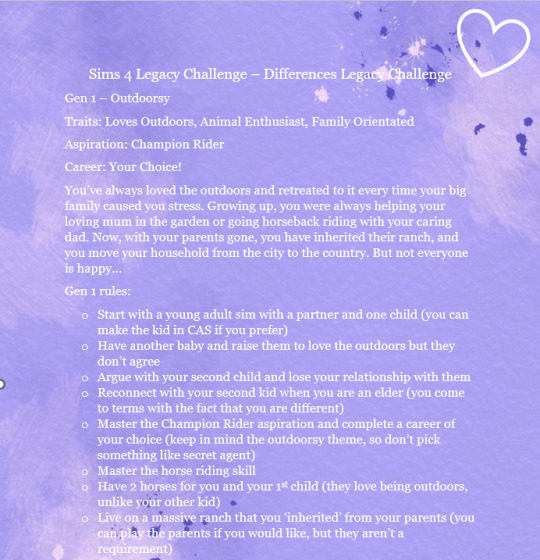
Hello!! <3 This is my first post, so I'm very nervous but here we are! :))
I made this challenge because, for me, Sims gameplay can get very boring and repetitive, so I wanted to make something that had things I could look forward too. I've only made gen 1 so far (that took way longer than expected XD) but if you'd like to see more gens, let me know because I have ideas!! You will need packs for this challenge, not all of them, but a few (e.g Horse Ranch if essential for gen 1). I've tried jazzing up Horse Ranch to make it more exciting, because, if I'm being honest, it was really underwhelming.
Hope you enjoy, and tag me in any posts if you try it! :)))
Love you all, and thank you so much for reading this and supporting me!! <3
Foxysims xx
2 notes
·
View notes
Text
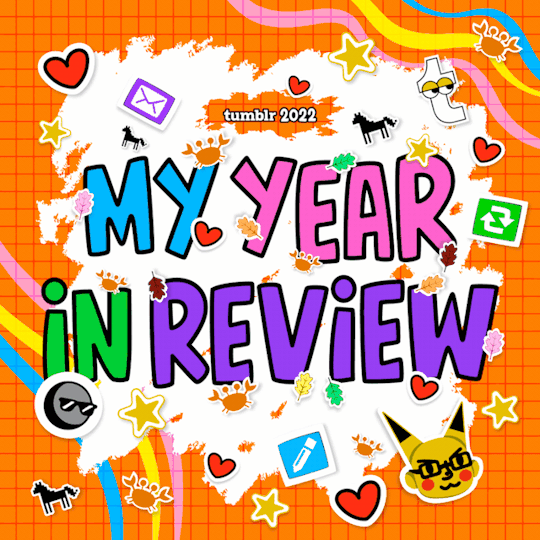
I posted 747 times in 2022
436 posts created (58%)
311 posts reblogged (42%)
Blogs I reblogged the most:
@mosneakers
@simsstuph
@queeniecook
@zosa95
@whyhellosims
I tagged 746 of my posts in 2022
#ts4 - 567 posts
#ts4 story - 266 posts
#sims 4 - 264 posts
#md4 - 248 posts
#reblog - 245 posts
#the sims 4 - 228 posts
#coraleye darling - 161 posts
#gif - 146 posts
#ts4 gameplay - 117 posts
#tycho curious - 91 posts
Longest Tag: 115 characters
#not really sure what this means but i wrote the original draft at 3 am after taking nyquil and thought it was funny
My Top Posts in 2022:
#5


See the full post
222 notes - Posted June 20, 2022
#4
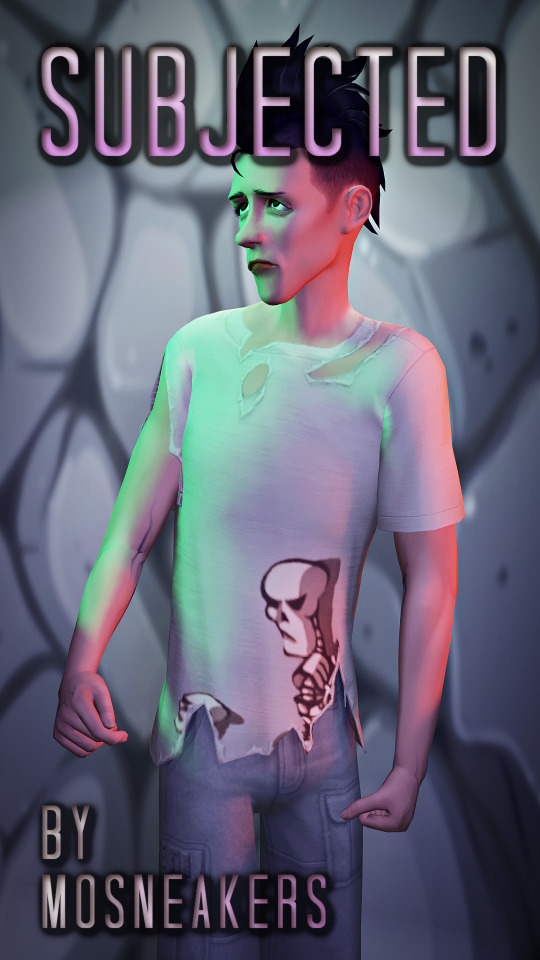
S U B J E C T E D- A Nervous Subject inspired ripped graphic T-shirt
For your sims who've seen some shit
Very busy so I'm leaving the Simblreen treats on the porch this year♡
Some of my lovelies have expressed interest in the shirt Nervous was wearing in my Moonkeeper render. So I figured it'd make the perfect Simblreen gift!
Maxis Match
Base Game Compatible (big tysm to @whyhellosims for helping me with learning this!♥)
For ts4
Includes an optional dirty or bloody ("costume blood") overlay, found in the ring category
Includes plain dirty or bloody swatches for those who don't want to download overlays
11 swatches all together
Made for masculine frames, but fem frames work too
🍬🍭🍫Download: (free, no ads or flies)
Patreon
Simsfileshare
more screenshots below:
Swatches in CAS:
See the full post
278 notes - Posted October 23, 2022
#3
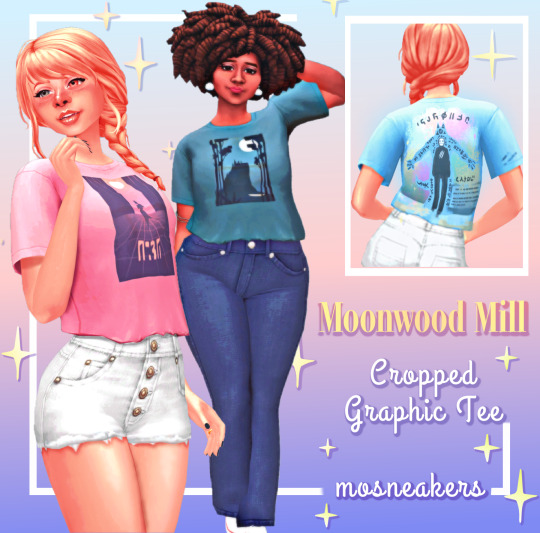

Moonwood Mill Cropped Graphic Tee🌙🌲
Don't take any trips to Moonwood Mill without picking up a werewolf themed cropped tee from the local gift shop!
Base Game Compatible
Fat Inclusive
Available for Masc and Fem Frames
Disabled for Random
Custom Thumbnail
Enabled for Wolf-folk (of course!)
Download (Free)
421 notes - Posted August 14, 2022
#2
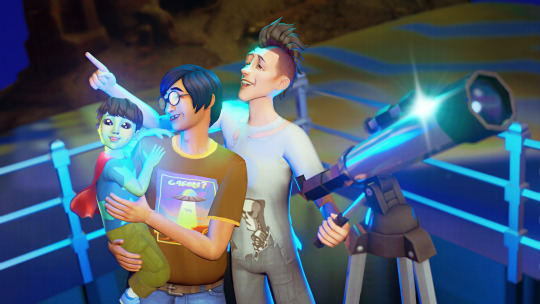

Tycho Curious, watcher of the cosmos, keeper of the moon! 💫🌕
755 notes - Posted September 29, 2022
My #1 post of 2022

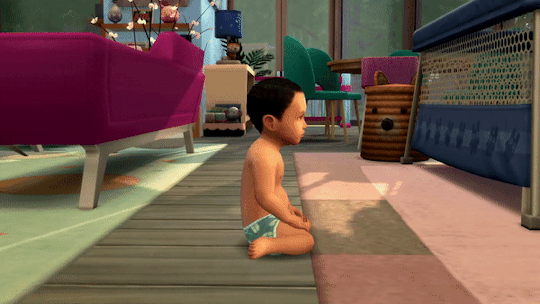
See the full post
2,746 notes - Posted October 18, 2022
Get your Tumblr 2022 Year in Review →
#tumblr2022#year in review#my 2022 tumblr year in review#your tumblr year in review#the fuckin baby gifset 🙄#gif
16 notes
·
View notes
Text
Playing Favorites (part 2)
Here we go again! Another 4 TS2 premades that really strange my town! (I’ll see myself out.) Anyway, I have to preface this with saying that so far I’ve only played the 3 base game hoods and although I really enjoy PV and VV, I added them to Strangetown just recently, so I’m still getting acquainted with their casts. That’s why my Playing Favorites posts are so dominated with desert-dwellers - but I definitely plan on including more non-ST Sims once I got to play with them more!
And I also low-key love everybody in Strangetown.
TOP 15 TS2 Premades (according to my personal tastes somewhere in May 2021) (not in any particular order) (and I can’t guarantee I stop at 15 either)
Tank Grunt (Strangetown)
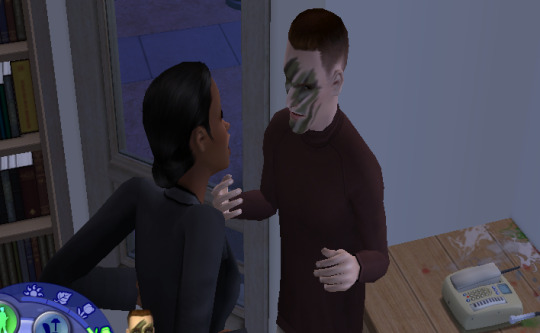
Yes, I am one of them. I am a Tank Grunt apologist. Brace yourself!
Similarly to the Pleasant twins, I view Tank as a victim of his father (Buzz Grunt, the esteemed Strangetown's Worst Parent Award nominee). Of course, that's not to say he's innocent. He is absolutely guilty of bullying Ripp and Johnny and equally guilty of being a bigot. And, most importantly, totally guilty of casually wearing camo face-paint. (that he canonically gets tatooed on his face down the line, which is... its own kind of tragic.)
But that is exactly why I like him so much!
Let me elaborate.
Tank is a very multilayered character, albeit a bit cliché. He is very artistic a eager to always do his best, whether that is in school or home where he competes for his father's affection and approval. Buzz provides both of that but it always feels conditioned – if Tank was to stop getting A+, stop parroting his opinions, stop working out, stop following in his footsteps, would that go away? Even though the answer depends on your interpretation of Buzz and his levels of horrible, Tank definitely thinks so. Just take a look on how his father treats Ripp!
I read Tank as somebody who believes firmly in order and good but has a very twisted understanding of both given his militaristic and hyper-masculine upbringing. He has an enormous potential for character growth. Can he gain (psychological) independence of his father? Can he follow his dreams and become a dancer? Can he free himself of his father’s biases now that he’s out on his own? Can he mend his relationship with Ripp and Buck? (...or maybe even Johnny?) It makes him so fun to play.
Also, I think that it was indeed very cowardly of the developers not to set his gender preference as gay.
Conclusion: Tank is fun! (Although he would probably resent me for saying that.)

Dina Caliente (Str- wait, Pleasantview)
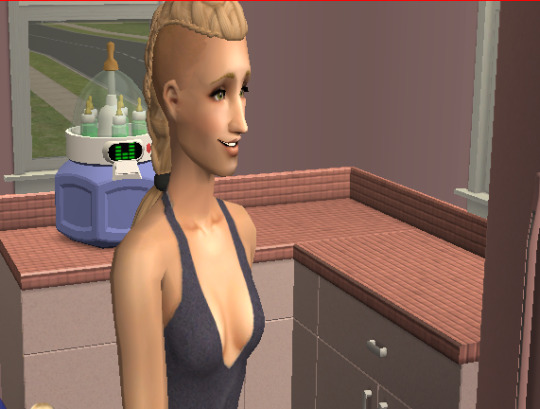
Finally someone who doesn't live in the desert! Both Nina and Dina are such interesting characters, with their connection to Bella’s disappearance, their alien bloodline and their opposing personalities and ambitions.
I feel like the sisters are often getting unjustly demonized. (or mixed up together, I’m looking at you, TS3 and TS4) They’re young, very attractive and in unconventional relationships, thus often labeled as predatory. They’re not.
Dina is a very nice Sim, with Nice points above the average and many Playful points and she tends to roll wants to start a family by the start of the game, although she is not a Family Sim. She’s actually a Fortune Sim, smart and business-oriented. She’s a widow who wants to remarry and has her sights set on the husband of her missing former sister-in-law.
I know that doesn’t make her sound that nice but there is nuance. First of all, the man in question is Mortimer Goth, well in his twilight years, a father of two, simply an adult. He is not a hapless trophy, the decision to start an affair with Dina not long after his first wife got pronounced missing, is his own. He knows he won’t be here for long and doesn’t want to die alone, he wants someone who can make him feel young again and loved once more. Dina, on the other hand, pursues a shotgun wedding to take an advantage of the Goth fortune that will kickstart her business ventures but she is ready to provide what Mortimer needs. She canonically loves him. (proven by the love flag in her relationship panel)
In my personal gameplay, I had Don take Dina on a date before their marriages to their respective Goths, and Dina kept rolling wants to flirt with Mortimer instead. Later down the line she also helped out the Brokes financially, and after her close friend Brandi died young in childbirth, she took in her youngest children, so that her oldest son Dustin could go to college and not worry what’s gonna become of his younger siblings in his custody while he’s gone. I figured it made sense because of Dina’s Nice points, her relationship with Brandi and her now being partially in charge of so much money it isn’t even funny.
In conclusion: I support and condone Dina! Even if it’s somehow implied that she and her sister might’ve just staged her rival’s alien abduction.

Circe Beaker (Strangetown)

Circe is yet another... unwholesome character on my list. She canonically tortures people, namely Nervous Subject, and her bio eludes to there being more in the past or the future. She's cunning, ambitious and very mean.
But she is also very fun to play! Her aspiration being Fortune (not Knowledge) puts an interesting spin on the whole evil scientist routine. She doesn't do it for the love of discovery like the Curiouses and she doesn't care about credit as her husband does. She's out for power and she may as well get it.
Her rather extreme personality would lead one to think she has to be rather disliked around the town but her default relationship panel says otherwise. She doesn't have any close friendships except her husband, though. That makes me think she is superficially charming and tends to act diplomatic to obtain people's loyalty without necessarily caring about any of them. It makes playing her unique from most other Sims.
She is also canonically bisexual! I personally have a deep appreciation for each and every Sim that Maxis sneakily preset to be LGBTQ+. I may not seem like a big deal now but it is.
Conclusion: "She could gaslight, gatekeep and girlboss me any day.” - half of Strangetown’s population
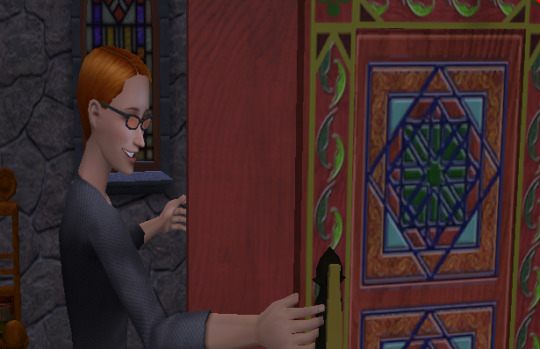
Lazlo Curious (Strangetown)

Lazlo is a ray of sunshine in the Curious household! A very sloppy ray that makes messes wherever it goes, true, but sunshine nonetheless.
I’m very fond of Lazlo because he’s the type of person that looks like he can barely count to five with his easy-going and messy nature but is in fact very clever and, by some measures, the most competent Curious brother, since he is the youngest and it seems like he’s fresh out of college, yet holds a higher career position than his older brothers. “A smart person that doesn’t necessarily seem smart on the first glance” is a trope I have a big soft spot for. (...and it shows)
In my current gameplay, Lazlo wanted to resurrect Vidcund (who died in childbirth), so he switched from Science to Paranormal to swipe a Resurrect-O-Nomitron and, like the madlad he is, succeeded before their round was over (in a span of few days). It was a combination of dumb luck and him having a compatible degree that gave him a hefty bonus but it still made me realize Lazlo could achieve whatever he sets his sights on.
Luckily, his sights are generally set on pizza and video games.
(relatable)
Anyway, I find Lazlo somehow cute, most probably for his constant and very unfruitful attempts to make Vidcund laugh, and in general, how friendly and easy to get along with he is. While he doesn’t have that many Nice points (5, which is a pretty average number), combined with his playfulness he usually tends to act very amicable.
In conclusion: I simp for Knowledge Sims and it shows.

Ok, I’ll be back with another 4 when my horrible procrastinating gruel of a brain feels like it. See ya!
#the sims 2#ts2#premades#simbrl#the sims#lazlo curious#circe beaker#dina caliente#tank grunt#strangetown#pleasantview
32 notes
·
View notes
Text
Bubblegum Legacy Family: Day 1 Adventures!
played my legacy challenge file for a while yesterday and made a lot of progress in my Gen 1 starter sim’s life so far; here are a few highlights!

so, to start things out, i of course moved my starter sim, Bobbi Bubblegum, onto the biggest empty lot in my chosen neighborhood and set her money to 1,800 (the amount that the legacy challenge site rules state to start out with IIRC), leaving me with just enough to buy the absolute survival essentials:
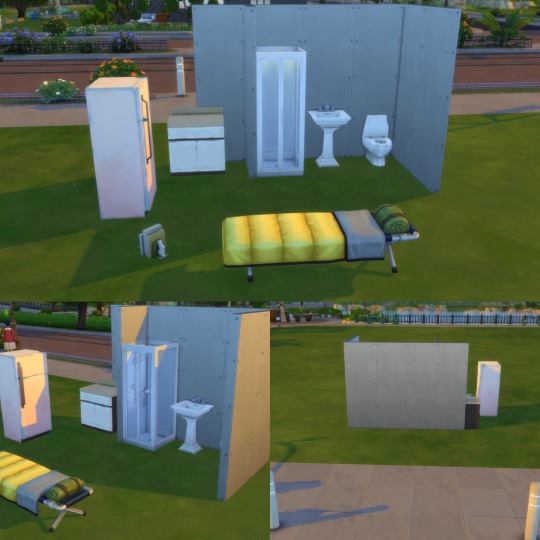
(i put some extra walls on the sides of the bathroom area because i remember having issues in the past with sims on legacy starter lots not wanting to use the toilet or shower because other sims walking by could see them LOL)
this left Bobbi with a few simoleons to make herself a few dishes of salad that i stored in the fridge as leftovers so that she could have some backup food if hunger became an urgent issue in a no simoleons situation.
Bobbi is very into the cottage life aesthetic, so i got her a job as a gardener (haven’t gotten to do the first day of it in-game yet ‘cause it was the weekend) and put a couple of plots down for her to practice planting to improve her gardening skill a bit
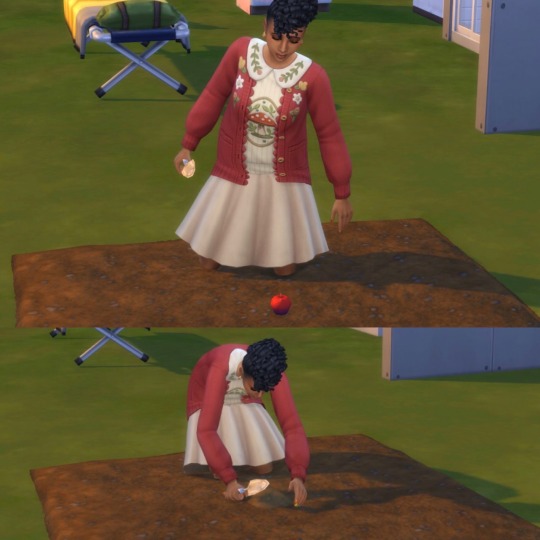
there was also this random geode rock that kept spawning like two times on the edge of her lot so i had her dig that up lol, she found two little My Sims figures that i thought were very cute ‘cause i loved those games as a kid + i placed them next to her small makeshift library next to her cot bed
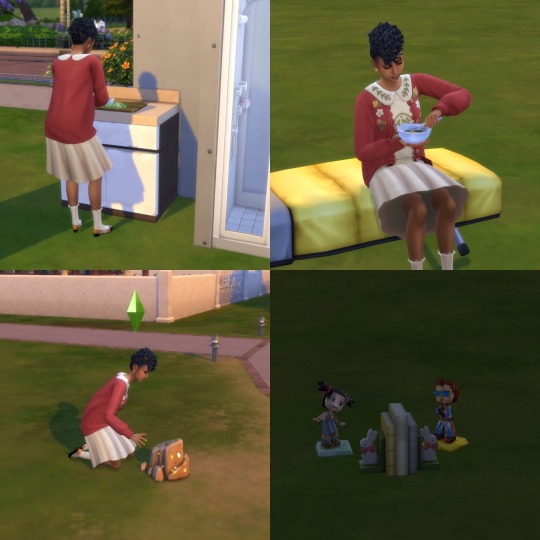
since it was the weekend and she didn’t have work to do, i figured it’d be a good idea to get a head start trying to build up some friendships & possibly a relationship for her! she visited a few cafes and parks and did a lot of socializing, and ended up making two pretty good friends within a few in-game hours
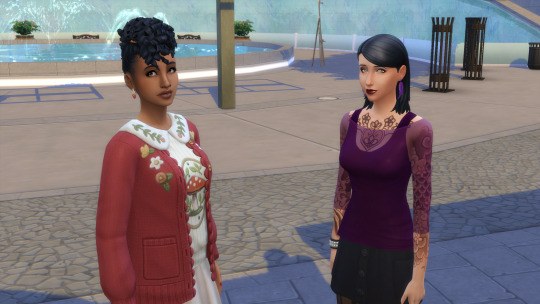
this townie was her first friend, and i think her style is adorable, so i tried to see if they might be a good fit as a couple, but the townie sim was a part of a Cool Scary Emo Club and Bobbi kept getting pop-ups saying she was like, nervous about her reputation going down because of their interactions or something along those lines haha. they were already friends so i didn’t want to sabotage that or anything, but i figured this sim probably wasn’t the best match for Bobbi, and i want her to be as happy as possible and hopefully live a great, long life, so we moved on to making some other friends around town!
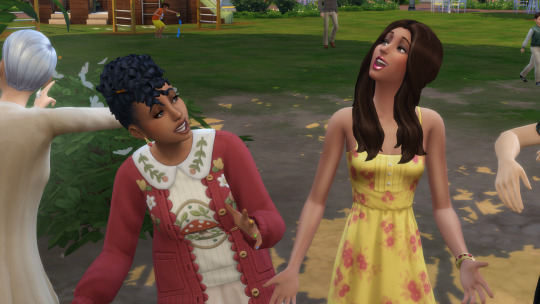
that’s when she met Zoe Patel, another pre-made EA townie, at the park. they got along super well and became fast friends! Zoe’s interests and general attitude seemed to click a lot better with Bobbi’s, so i decided she would be the new relationship goal sim. and luckily it all worked out quickly!
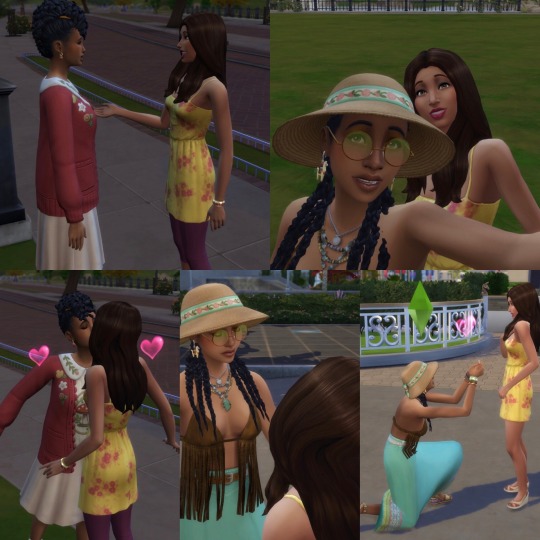
they totally hit it off and i was quick to have Bobbi propose and secure The Generation 1 Spouse LOL. as Zoe had quite a few overlapping interests with Bobbi, i thought it would be nice to set her on a similar job path, so i signed her up to be an environmental conservationist! she’ll be starting her first day on Tuesday, the same day as Bobbi’s first work day. Bobbi’s life goal is to have a nice farm for both plants & animals (i just got gifted the Cottage Life expansion by my bestie irl so i was very excited to immediately jump into that pack’s gameplay cuz i am very much a cottagecore person too haha), and Zoe’s is to be a friend of the world, so i think as long as i’m able to do a decent enough job juggling their social lives, work lives, and eventual family relationships and challenges, i’m crossing my fingers that they’ll both get to see their aspirations through before the end of the first generation gameplay and household send-off to the next eventual heir!
i also gave Zoe a CAS makeover because i’m not the biggest fan of the base EA townies’ styles/makeup/etc etc and i tend to use a lot of CAS CC in my households; i’ll make a separate post eventually with more pics, but here’s how she looks now!
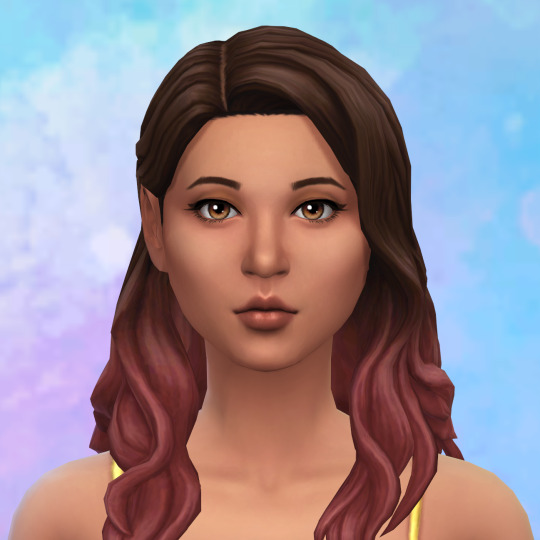
i give townies makeovers very often in my games, and when i do, i don’t like changing any of their actual genetics like skin, eye color, face shape, etc, i just like using their EA appearance as sort of a template to add fun looks onto! i swapped her base eyes out for CC eyes in the same color (sort of an amber brown shade), added a faceblend to add some more depth to her face a bit, and gave her new outfits & hairstyles that were similar to her pre-existing style. added the pink ombre to her hair in a few outfits where it worked with the hair just for a fun splash of color since i love non-natural hair dye colors irl and for sims :-)
i’m excited to make more progress for this growing family! i already love Zoe so much and i think she’s a perfect fit for the Bubblegum household <3
here are a couple other pics i took while playing last night too
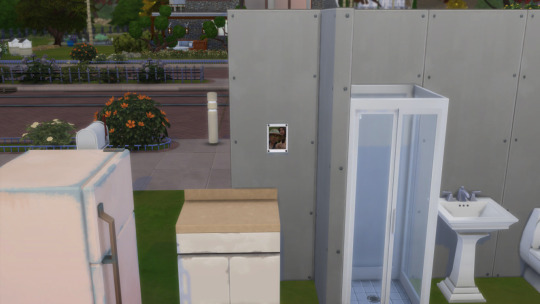
this is a selfie Bobbi took of her and Zoe that i put up on the wall cus i think its cute and in my sims 3 legacy house i almost always had at least one family portrait/art piece of the main adults in each generation, i just think it’s a sweet way to carry on their individual stories/memories as the challenge goes on!

this was when i was trying to get a good pic of the gals interacting and this funky mailman walked by and it cracked up.....love that guy
#ts4#the sims 4#ts4 legacy#ts4 legacy challenge#legacy challenge#household: bubblegum#sim: bobbi bubblegum#sim: zoe bubblegum
2 notes
·
View notes
Text
@summon-daze replied to your post “lukewarm take but idk... nobody (at least not this century) says shit...”
Great post but whats the game mentioned? I'm curious
Thank you! I was super nervous to make it so that’s reassuring. <3
The game I mentioned is Rimworld!
The premise of the game is that you’ve crash-landed on a foreign planet and must build a colony, survive raiders, and prosper long enough to build a ship to get back off-planet. All this time, there are events that have a mathematical risk of happening (such as volcanic winters, cold snaps, flashstorms, and so much more) to make it a sort of storytelling game for your colony!
But honestly the beauty of this game is in the details and the lore! It’s like a dark scifi-esque galaxy of planets outside of the planet you crashed on. Imagine Le Guin’s Hainish Cycle but less literary and more bent towards the portrayal of tropes in fanfiction/pop culture, like prostitution, space pirates, and human traffickers. The darkness of the lore is exactly what appeals to me and what makes this game more intriguing than any other sandbox/colony-building game I’ve ever seen or played.
For example: with the base game, you can capture the raiders who periodically come to attack you, and you can either recruit them, release them, execute them, or harvest their organs for profit lmao. Sometimes factions will come by to trade and you can sell your prisoners to them, too. When things get tough and you don’t have food, you can also butcher human corpses and cook them into meals. Another example: mental breaks! If your colonists become unhappy enough, they can do anything from hiding in their room to digging up a corpse and displaying it on the dinner table (depending on how severe their mental break is). So yeah it’s clearly very dark and morbid gaming that isn’t often done and doesn’t appeal to everyone. (Hint: It definitely appeals to me. XD)
Another thing I really like about Rimworld is it’s blend between strategy games and more Sims-like games. You can control every single colonist individually, which makes it like Sims, but you can also set up the colony’s work priorities in a way that makes them act optimally without you having to guide them!
If you are the person that liked to drown your Sims in the swimming pool or light houses on fire, I highly, highly recommend this game to you!
Of course, Rimworld is not a perfect game and I will never claim it is such! It’s very heteronormative (honestly pushing lgbt-phobic). The game (which was an early access steam game) was made by what feels like the exact stereotype of a reddit dudebro-nerd coding from his momma’s basement because it’s the feeling of progressiveness (or the lack of) that his game gives me lmao. (No offense to such people, I have a severely mentally ill family member who is one of them. My family member knows bisexual ppl exist though lmao.)
The other problem with Rimworld is how boring it gets after playing it enough. There’s only so many events, so much mystery, before it kinda starts to lose its thrill.
However, this is where mods come in. And I’m telling you, this is literally where the game shines the hardest - the modding community. If you play Rimworld without Mods, then you’re not really enjoying the full experience lmao. The Psychology Mod for example adds in a lot of shit, including more sexualities, social interactions, and mental illness that the base game doesn’t have. There’s the Prison Labour mod where you can make your prisoners do work for your colony (haha, perfect for my Grandmaster-led colony). There are mods that add children/pregnancy, gladiator arenas, and the need for showers&water. That honestly doesn’t even begin to explain how many mods I use and how much they enhance the enjoyability of the game! I use like 50 mods and I’ve logged almost 500 hours in gameplay now soooo yeah, haha. Playing without mods is like playing Sims without expansions.
Anyway this finally brings me to the point of the original post, sigh. There is a mod called Rimjob World that I have found recently that adds noncon and sexual slavery (and even prostitution game play) to Rimworld. This mod was created by people who... equally fit the reddit dudebro-nerd coding from their momma’s basement stereotype. T_T I don’t agree with a lot of the language that the mod uses (i.e. adding trans characters but calling them “traps” or “futas” -_-) or a lot of the systems that the mod has set up (i.e. the default settings categorize women in a way that implies only certain women rape and only certain women get raped).
I’m very frustrated with this! I’ve spent a lot of time trying to find another mod that puts the lack of noncon into this barbaric and violent world of Rimworld in a less problematic way. But when I look for it, there is nothing. And instead I’m always hit with comments (especially on reddit) like the one I mentioned in the post.
It always comes down to people thinking it’s okay to have games/mods with slavery, cannibalism, and organ harvesting, but making those games include rape is a step too far. -_-
It’s disgusting and just as rape culture-ish as the opposite expression imo.
Anyway sorry to ramble about this, I know I’ve complained about a lot of these things a few times, but it never ceases to infuriate me lmao so I figured I’d just consolidate all my thoughts (along with the positive ones) about Rimworld into one post! So thanks for the opportunity and I hope this was helpful! Have fun if you play and also:
Anyone feel free to hit me up for my recommended mod list lmao because this game can get so boring without it.
Also if you’re not sure about the game and wanna see some gameplay, I do play rimworld on stream sometimes lmao, but I’m a lame newbie streamer so feel free to find... other sources to watch let’s play videos too XD
#summon-daze#lox replies#tw rape#cw noncon#rimworld#the rimworld post#for reference later in case anyone asks lmao#there's a lot of shit i probably need to blacklist here but i'm too dumb right now#so sorry#lmk if i missed anything
4 notes
·
View notes
Note
Hi! Do you have any tips for playing a legacy? I noticed you were on Generation 2 of yours.
Heya Love ❤️ 😊!
To be completely honest I didn’t follow any rules when starting out except for 1. Only 1 Sim 2. Must be YA 3. No Money Cheat.
I think that made me feel more creative in the beginning than I would have if I imposed all the main rules. (HAHA I had wanted to try for ALONG time but was very nervous to try something with many rules. I get frustrated easily LOL 😆)
Does this count as tips/advice 😅
It was my first attempt at a legacy challenge. I wish I had more advice for you ❤️! I’m getting burned out on this family TBH (I haven’t actually played them for a HOT minute). I was think about starting a new one and actually posting gameplay 😊!
1 note
·
View note
Text
♡ Simblr Questions ♡
I saw these questions reblogged here, and I’m killing time again, so....
1) Which is your favorite Sims Expansion?
TS1: Makin Magic | TS2: Apartment Life & Night Life | TS3: Supernatural
2) How long have you been playing sims?
19 effing years. *pours another shot of Pepsi*
3) Do you have any favorite simblrs?
One of the very first simblrs I ever followed was Kosmokhaos. They’ve been wowing me since their days at Cstyles, and I’ve been in love with their style & creativity. So. Yeah.

4) How would you describe your gameplay?
Derivative and sporadic. I'm almost always inspired by fandoms -- shows I watch, other games I play, and things I’ve read. I bounce around regularly, and my gameplay reflects that -- one week I’m doing this, and the next week I’m doing that. I might not return to something for months or even years. Who knows. Welcome to my crazy.
5) What made you want to create a simblr?
I was lurking Momosims’ blog for CC, and TSR was getting on my nerves. So I killed 2 birds with 1 stone -- I was able to follow Momo, and post my CC conversions without needing to follow some other site’s rules and whatnot.
6) What is your favorite Sim age?
Young adult, of course. The Sims is just not optimized for the younger & older ages, despite there being an entire expansion pack dedicated to them. It’s ridiculous.
7) Do you use cheats when you play Sims?

8) What is your favorite thing about the Sims?
I was drawn to The Sims 1 because I love interior decorating, and when I was younger I was obsessed with architecture & design. My favorite part of simming is building lots. I only create CC cuz I’m often frustrated by the lack of objects I want to see in my sims’ homes. And I effing HATE making CC.
9) What is your least favorite thing about the Sims?
I'm strongly influenced by fanciful genres, so I am most interested in things from different time periods, cultures, religions, etc. And that’s like the least represented theme in the community. I wish more simmers would get into fanciful gameplay, particularly more content creators. The more simmers who play that way, the more we can influence EA to stop making boring AF packs about the same ole boring generic predictable stuff.
10) What expansion pack are you hoping for next?
The first TS4 EP to even marginally interest me was Seasons, cuz they added more holiday stuff than TS3 did. And they had that Day of the Dead patch, which was COOL. I hope they’ll keep including more holidays and festivals like that - give the Sims some multiculturalism, EA, dang. This franchise is so Westerncentic Californiacentric it makes me wanna puke.
City Living is a step in the right direction - I love the boho Asian-ish thing they added -- too bad it was in a weak AF half-baked EP where the “city” was just distant terrain. It’s mess like that that makes me nervous to even ask for a more fanciful EP like Medieval times or Steampunk, cuz the game engine's so dang limited. There's no horses, cars, or any transportation -- so how can we have knights? Or a live-in dirigible? Or dragon riders? How can we have mermaids or Pirates of the Caribbean or Chinese junk ships when sims can’t even swim in the frikkin ocean? Expand on THAT, EA. Ugh!
11) Do you like to play the Sims in the morning or at night?
Whenever I have free time.
12) Do you have a aesthetic for your Sims?
It depends on the gameplay. I TRY not to make my sims look too pudding, but I don't use reshade and HQ mods and any of that fanciness, so.... :\
13) What are your favorite Sim names?
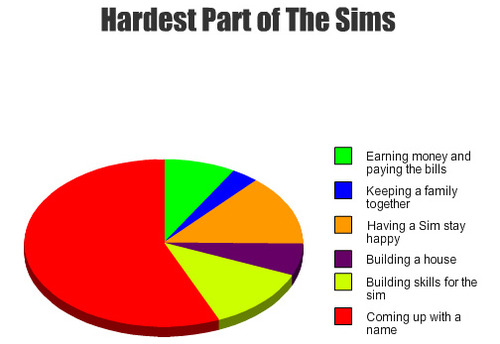
14) What is your favorite Sim Career?
The Ghost Hunter from AMB, and the Magician from SHT.
15) What is your favorite Sim World?
Shang Simla, as always~!
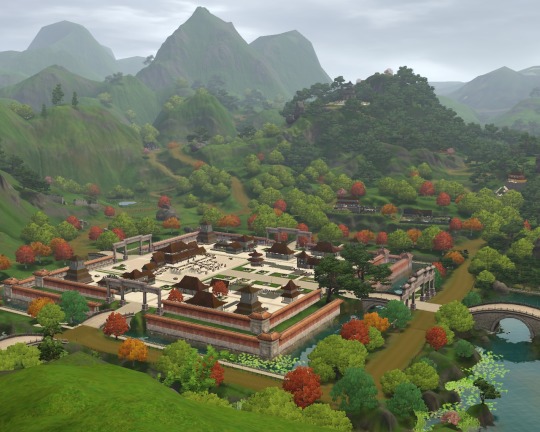
It’s just so effing gorgeous -- the misty mountains and the DRAGON cave and the colors and the culture and the foliage and just everything about it. World Adventures was freaking awesome.
16) Do you prefer small or large Sim houses?
Larger houses tend to not have as many routing issues, plus you can add more clutter in them! I’m a cc-holic, okay.
17) Do you prefer more modern or traditional Sim houses?
Traditional. Which is ironic, cuz one of my 2 main gameplays is my Nagron couple, and they live in a modern home in freaking Starlit Shores. :P

But I chose that cuz this is how I play TS3 the “straight” way (LOL!) -- I took my Spartacus sims out of their original medieval-ish save, and integrated them into a modern AU. So the fun for me is how I imagine these 73 BC characters would live in today‘s time. (Which is why I use Nagron for all the OC prompts & questionnaires I do, too).
18) What is your favorite Sims Challenge / Prompt?
The Simblreen photo challenge -- I always look forward to seeing what simmers come up with; Simblr turns into Halloween Town, and I love it.
19) What Sim emotion would you most often be?
Asleep.
20) What is your favorite skill to level up?
Spellcasting.
21) Describe your favorite Sim.
I’ll just direct y’all to my Nagron Page, cuz I describe Nasir all the time. :P
22) What kind of computer do you play Sims on?
As of Nov 2017, a Windows 10 Dell laptop. Before that I was on a HP Vista laptop, which I sorely miss.
23) Do you use Mods in your game?
YES
24) How many hours of Sims do you think you have played?
Thousands. Mostly spent in Build/Buy mode. :P
25) What are you planning to do next in the Sims?
I have some conversions I’m working on, a few requests I took, some lots I want to get started on, some gameplay pics I need to finish, and just a bunch of simming!
I’m just so tired & low energy right now. But this is my last couple of months of free time I’ll have before I go to grad school in the fall, so I want to get as much done as possible. *sigh* I’m stressed.
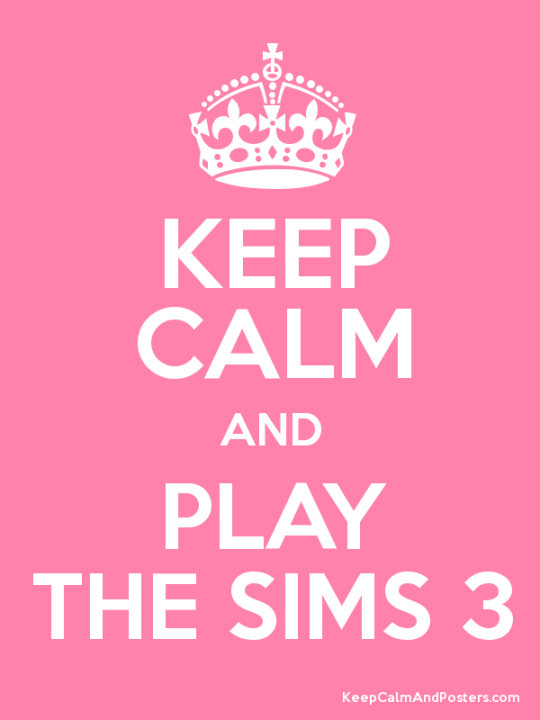
I tag everyone!
17 notes
·
View notes
Note
Answer all the simblr questions~ ;)
Good gravy, Elle! Here we go!
1. Which is your favorite Sims Expansion? TS3 was Supernatural and TS4 is maybe Seasons or Strangerville? We haven’t had anything yet that makes me think “yes perfect.” (I didn’t have any TS2 expansions as a kid)
2. How long have you been playing sims? Since about 2006 or 2007, over ten years
3. Do you have any favorite simblrs? Way too many! If someone reminds me at some point, I’ll do a separate post.
4. How would you describe your gameplay? The Butterbeers is kinda “guided” gameplay where I have an idea of what I’d like to happen. The Midnight Sun save I’m working on is a “whatever happens, happens” deal. And the Faust vanilla legacy I’m playing is literally just two steps from “god mode” bc I’m playing fast and loose and interfering with cheats and mods. I am...multifaceted.
5. What made you want to create a simblr? I had one years ago before TS4 that I liked even though only like, two people followed, but I got super embarrassed about it and deleted it. It was attached to my old personal tumblr so it’s definitely gone, now. This time around, I’d seen a couple new simblrs come up in my recommended on my other tumblr. I’d never played through a full rainbowcy before and after reading Cait’s, Tai’s, and Kit’s I wanted to try it out.
6. What is your favorite Sim age? YA, I think. There’s so much possibility!
7. Do you use cheats when you play Sims? I use MCCC minimally in challenge saves, but in gameplay saves, anything is fair game. My simself is RICH and maxed all her skills.
8. What is your favorite thing about the Sims? There are almost no limitations, and there are usually mods to open up even more avenues of play. There’s just so much to explore and even when I’m not writing a story with my sims, they still feel like real people.
9. What is your least favorite thing about the Sims? Death by laughter!! Why would that be an option?
10. What expansion pack are you hoping for next? SUPERNATURAL.
11. Do you like to play the Sims in the morning or at night? Uh, yes. I play when I have the time and motivation, which isn’t as often as I’d like.
12. Do you have a aesthetic for your Sims? I’m not sure. Does colorful count? Even my vanillas live in bright houses and clothes and things.
13. What are your favorite Sim names? Pollination Technician #9 Smith, Nervous Subject, everyone in Veronaville, the last name GOTH, the last name Pancakes, and I’m sure there are more but those are the ones I thought of off the top of my head.
14. What is your favorite Sim Career? TS3 I loved all the supernatural careers as well as the diving one and criminal. I kind of get frustrated with TS4 careers so I prefer making money in other ways, and in TS2 I just cheated all the money!
15. What is your favorite Sim World? TS2 is Strangetown, TS3 is Moonlight Falls and Oasis Landing (I wish I’d gotten Midnight Hollow and Lunar Lakes!), and TS4 is Strangerville and Selvadorada but I can BET it will be Forgotten Hollow once I buy Vampires.
16. Do you prefer small or large Sim houses? Depends on what family I’m playing: if it’s a big family with lots of kids I like massive houses but I’m also super fond of one or two sim tiny cottages.
17. Do you prefer more modern or traditional Sim houses? I think the last time I purposefully made anything “modern” I was still playing in Oasis Landing.
18. What is your favorite Sims Challenge? Rainbowcies and Legacies! I love a good generational challenge.
19. What Sim emotion would you most often be? Oof, anger. I’d be annoyed by routing issues and about a billion other things.
20. What is your favorite skill to level up? Cooking! I wish they weren’t so helpless when they start out, but I love watching them cook better and more elaborate things.
21. Describe your favorite Sim. I’m going to assume this means a premade? I’m weirdly partial to Erwin in Strangerville, honestly. As soon as I saw him, I loved this little conspiracy nerd. He’s dorky with big glasses and bright red hair and always bugged. I MAY have married my simself to him after I finished the Strangerville storyline...
22. What kind of computer do you play Sims on? An HP laptop, no idea what kind or anything but it’s 17in. I had to buy a massive backpack but the screen is worth it!
23. Do you use Mods in your game? Yep! Currently just the MCCC but I had Basemental Drugs to try it out and I also had the Hoe It Up mod for like a week? Neither of them are my thing so I deleted them. I may have some other small mods like the leaf piles not stinking but I’m not sure.
24. How many hours of Sims do you think you have played? Well, I usually only sit down to play if I have at LEAST 4-5 hours to play and I’ve been doing that for literally half my life sooooooooooooo A LOT.
25. What are you planning to do next in the Sims? I want to finish the Butterbeers for sure. That’ll probably happen sometime next year, at the rate I’m going. I have a couple other vanilla saves I play regularly but I hesitate to post them bc I’m not sure I want to share them and sometimes I get nervous about posting vanilla. As of now, I’ve abandoned my Kudzu Tarot story. So, I guess I’d like to find another berry story to tell! I haven’t really thought of which to pick though, but it would probably be a Disney Princess Rainbowcy or a Sweet or Sour challenge or something!
1 note
·
View note
Text
Pretending To Be Famous In the Sims

Often, the appeal in playing The Sims has watching humanoids navigate barely exaggerated scenarios inspired by your own life: finding a job, finding love, and, with luck, living to see old age. Let’s check to Pretending To Be Famous In the Sims.
Major game-play additions—“expansion packs”—can propel the game ever closer to real life, in all of its monotony. Get to Work, released in 2015, extends gameplay from the home to the office and allows Sims to open their businesses. City living, from 2016, allows you to hunt for an apartment in the big city. 2017’s Cats & Dogs and 2018’s Seasons let Sims experience animal companionship and weather, respectively. Sims 4: Get Famous, released in November, introduces social media and influencers to play with another aspect of modern human existence: the managerial upkeep of identity. All details information pretending to be famous in the sims
When you install Get Famous, all of the Sims in your game has endowed with their public image, which has a two-part composite of their reputation and celebrity level, both measured in stars. Fame is a choice here, and Sims may “quit the spotlight” if they so choose. My Sim, Caterina Doherty (no relation to the baroness), began her life as a young adult, a zero-star Unknown with a neutral reputation. She chose to remain in the public eye, of course—I specifically created her so that she could become wildly famous.
This latest expansion pack is not the first time that the franchise has played with the idea of fame. I remember chasing celebrity in 2003’s The Sims: Superstar. Which allows you to turn Anybody’s into A-listers and incorporates the likenesses of real-life stars, such as Andy Warhol and a “Dirrty”-era Christina Aguilera, and also 2012’s The Sims 3: Showtime. Both games channeled fame through the usual showbiz disciplines: singing, acting, or otherwise performing on stage or camera. Although celebrities in Showtime can greet other Sims with an “Ever heard of me?” and, in the more cynical Superstar, suffer nervous breakdowns that get reported in the tabloids, the games made chasing fame seem like an honest living.
In the years since Showtime, though, the nature of celebrity has changed: movie stars are on television, television is online, and online is everywhere that meets the eye. But the game incorporates those changes without judgement. “Our goal isn’t really to parody them,” said Grant Rodiek, a senior producer at Maxis, the studio behind The Sims, speaking to The Verge about the new in-game Sim influencers. “Really what we do in the game is generally lighthearted . . . We present this as a serious career, a real career, a real way to go about making a living.”
It should be noted that getting rich, available as a rewarded objective since Sims 2, is much easier than becoming famous; any Sim that goes to work and spends thriftily can be affluent before old age.
The usual Sims pathways remain in getting Famous—actor, musician, author, stylist—but now characters can also accrue fame in their free time or even without formal employment. In the spirit of things, I made Caterina a full-time social media influencer. A bright-green “+Fame” qualifier allows users to nudge their Sims’ celebrity level by directing their Sims to post social-media status updates or upload photos to Instagram.
There’s no Simified SoundCloud or YouTube, but Sims can produce music tracks, upload vlogs and product reviews, and collect daily royalties according to viewership. I found myself drawn to those glowing bonuses like a dumb moth, choosing the weighted options every time they appeared. Between writing a column (which doesn’t affect fame scores) and writing a blog post (which boosts fame scores), I chose the latter; I shilled every snapshot doubly to Simstogram and the press; every amateur painting went for whatever an art dealer was willing to pay.
Get Famous makes two types of in-game drones available for purchase with Sims money. And Sims can upload pre-recorded drone footage or stream life, quickly gaining bursts of new followers. Were the device not limited by what felt like brief battery life. I would have bid my Sims to live-stream everything for the sake of exposure. You cannot, I’ve discovered, take drone footage of Sims mid-“woohoo,” the game’s euphemism for sex.
Still, I has unpleasantly surprised at just how much of a grind the game’s “path to stardom” has. Getting famous takes forever. And it is more fun to be famous than it is to get famous. As Caterina spent her time interviewing strangers. Improving her writing skills, and blogging for attention—advancing from Rag Reviewer to Culture Columnist—something told me that I’d there before.
In one work dilemma called Freelance Op-Ed, a Sim must submit either a “hard-hitting exposé” or a “fluff piece” to, as we’re told, “THE premier culture review zine.” With journalistic gumption, I directed Caterina to chose the exposé. only to receive a decline in “hygiene” and “work performance,” though the game notified me that the decision “leaves her feeling empowered.” I had there before.
0 notes
Link
The following blog post, unless otherwise noted, was written by a member of Gamasutra’s community.
The thoughts and opinions expressed are those of the writer and not Gamasutra or its parent company.
For the eighth consecutive year, the Level Design Workshop will be hosted by GDC on Tuesday, Feb 28. Once again, we've assembled an exciting, diverse lineup of rockstar speakers from all walks of game development life.
A smiling @pabosher looks on. This photo is actually from the 2016 narrative summit, but I can personally assure you Philippe looks just as cheerful when attending the LD Workshops.
Whatever kind of games you make, level design is the lens through which players are most directly exposed to the underlying rhythms of your creation. And as the medium of video games has become increasingly broad and diverse, the techniques and ideas that go into level design have also broadened.
With that in mind, let’s introduce the roster of speakers for the 2017 LD Workshop, after which they’ll bat around some questions submitted by the LD community via social media.
- Joel B
Matt Thorson
@MattThorson
Matt shares lessons and insights from his process in designing the 300+ interconnected levels for mountain-scaling platformer Celeste, his team's follow-up to TowerFall Ascension. It's a bit of a scattershot of topics, including inspirations from real-life rock climbing, designing for speedrunners, structuring rewards, and teaching players implicitly with level design. Celeste is still in development and this talk goes behind the scenes on the processes and problems we've faced since setting out to create a modern, unique, and memorable 2D platformer.
Jolie Menzel
@joliemenzel
A Narrative Approach to Level Design details just that - approaching level design from the perspective of the story that the designer aims to tell with their level. This talk will give a glimpse into some of the design techniques that I've developed while designing on Telltale Games' narrative-focused adventure games, as well as on Ubisoft's upcoming RPG title South Park: The Fractured But Whole, presented in a way that can be applied to many different genres of games.
On South Park, all of our levels are derived from story scripts not unlike those used on the South Park show. It’s our designers' challenge to take these scripts and make them into enjoyable interactive experiences. I'll explain how we distill these scripts down to their core narrative elements, and use those elements as the backbone for our levels. We'll also apply this technique to an example script to drive home how to apply these techniques to any story.
Steve Lee
@essell2
Hi there - my talk, “An Approach to Holistic Level Design”, is about always thinking in terms of how gameplay, presentation and story is working together. It'll draw from my experience as an LD on games including 'Dishonored 2' and 'Bioshock Infinite', and the core design values of the genre known as immersive sims (as well as throwing a bit of Half Life 2 in there for good measure).
The topics I discuss emerge directly from the relationships between the output of different disciplines - namely "affordances", "intentionality", world building and my personal take on interactive storytelling, in the context of these kinds of games. My hope is that LDs of all types and experience levels can come away with clearer ideas about how to focus not just on gameplay, but the player experience as a whole - and how to make it richer and more engaging..
Lisa Brown
@Wertle
Greetings! I am a designer of many years, both in AAA and indie. My talk will cover my transition from doing level design in large 3D action games (Resistance 3, Sunset Overdrive) to a 2D overhead game (Hyper Light Drifter). When I first started on the project I was nervous as to whether my level design skills would translate formats, so I will talk about my fears of what wouldn’t carry over, and then the many processes and principles that did carry over. My goal is to show that even specific and specialized design skills are still quite transferable.
Alejandro Quan-Madrid (Aquma)
@Aquma
What is a “video game mixtape” and how can I use this format to tell stories in new ways? I don’t know if these are the questions that keep you up at night, but they are for me. In my talk we’ll go over how to create a good flow by mixing and matching a variety of simple game experiences. When the player goes through them in a specific (or out of) order, their minds start to make up their own narrative. See how we play with those expectations with examples from my debut, autobiographical video game mixtape FRKN WKND and with a couple of other recent mixtape games I’ve made.
Clemence Maurer
@Moutrave
My conference topic will focus on the design process we use to build an immersive and consistent exploration experience in the game's main City hub of Prague.
I'll describe how we started sketching our high levels needs and ideas regarding the general exploration navigation around the city, and how we could entice the player into constantly discovering new locations of interest, offering both interesting challenges and satisfying rewards.
I'll also describe our approach to creating compelling mini stories through analysing the greater Cyberpunk genre as well as our own particular conspiracy driven, deep and brutal main narrative, in order to breathe life into the "ordinary with a twist" citizens of Prague, who all contribute to making the game world consistent, meaningful and relatable.
Robin-Yann Storm
@RYStorm
Last year I gave a talk at GDC about how to improve your tools & level editors. It was well received, and many commented how they liked the solutions, but one question kept coming up: How do you make all these improvements without hiring 10 more tool programmers? And that is a fair question.
Over the last year since GDC 2016 I have gone around the game industry asking experienced developers from AAA companies around the world: What do you do to make sure the right features get worked on? How do you triage the hundreds if not thousands of requests into what you will and will not improve on in your tools & level editor?
In this talk I am going to go over the many production methods and approaches game developers around the world have used, and are using, to make sure time is correctly spent on improving tools & level editors, so you can see what methods have been tried, and what you could do for your studio to improve your tools through improved triage.
Elisabeth Beinke-Schwartz
@ebeinke
What are the real differences when going about designing a singleplayer level vs a multiplayer level? How do you tackle layouts with different objectives, narratives, and combat needs that differ between SP and MP? There's a paradigm shift of thought that occurs when swapping between designing between SP and MP and I'll be drawing from my own experiences in designing narrative-driven SP levels along with my transition to designing MP levels. This talk will tackle the differences and similarities when swapping between designing for each, lessons learned about what you shouldn't waste as much time on, and how to go about planning playtests of SP vs MP levels.
What process do you have for designing gameplay through levels at a micro (level-by-level) vs. macro (over whole game) perspective? Ben Myres @_benjamming
(Robin-Yann Storm) I personally love designing around a mechanic or setpiece. Introducing a mechanic, playing with it on a micro level, and then swinging it in and out on a macro level can work well. A good video on that subject is this: https://www.youtube.com/watch?v=dBmIkEvEBtA.
(Lisa Brown) Yeah, having some kind of centerpiece mechanic can help link spaces together in the player’s mind in a non-visual way. For example, having a series of rooms based on some kind of trap or hazard that ramp up over time. I think it’s important to have pacing in mind both within the level, but also how that fits in the overall pacing arc of the game. For example, if you playtest a level and it feels kind of slow, but it happens right after BIG ACTION EXPLOSIONS LEVEL, you have to keep in mind its context in the overall pacing when you make adjustments.
(Jolie Menzel) Since I’m often working from the narrative space, I’m often coming from a macro perspective and working inward. I start by analyzing what I need the level to do from a story perspective and a gameplay perspective, looking for any moments where a player need to learn how to do something. Those things form a skeleton of critical beats. From there, I add in supplemental beats that will augment those critical beats and help to nail the overall feeling that I need the level to capture.
(Clemence Maurer) In a game like Deus Ex, that needs to support many types of players and proposes quite a big array of tools, we usually start from a defined, high level story beat and start working on our layout immediately, thinking mostly about how we can make something that can support stealth (multi-path, occlusion, verticality, vantage points…) and combat (cover, escape, flanking, open vs tighter spaces…). Our level needs to support every pillar, including the narrative driven ones such as branching conversations with “persuade” gameplay opportunities, so we spend more time designing it directly in the engine instead of spending too much time on 2D drawing for example. That way we immediately get a sense of scale and gameplay potential, easier to iterate upon. When we’re happy with the base layout we work inwards, making the level architecturally “alright” with our artists and defining the micro gameplay :what augmentation(s) would be need to get through that area? How do we convey this need in the environment? How do we spread them out to support a maximum of players with a heterogenous loadout?
(Matt Thorson) For Celeste we’re making the game holistically, which is a fancy-sounding word for figuring it out as we go. We have a lot of story, but we’re developing it alongside the gameplay for each area and we change both to fit each other. So sometimes our conception of an area’s story arc and pacing will change based on some cool levels we make, or a great story moment idea. Sometimes we’ll realize that a great level moment just doesn’t fit in the context of the area. We’re always zooming in and out from level to area to full game perspectives to re-evaluate our work, and a lot gets cut or repurposed.
(Aquma) For video game mixtapes, the focus is on the micro. I just build simple gameplay experiences/levels that percolate in my head over a period of time. After I make enough of them, I start looking at how to piece them together in a way that conveys are general story and vibe. The macro. The process is very iterative and not like passive media where you plan it all out in advance.
What kind of process do you follow to ensure that the levels communicate gameplay goals & environmental narrative lucidly enough? Michel Sabbagh @Watfen64
(RYS) You can use so many things: Lights, audio, geometry, etc, but playtesting is the biggest one for me. Build it, let players play it without telling them anything, and then see if they understood it clearly enough, by seeing them play and asking them.
(JM) Something I think is a really important to develop a sense for is allowing players some wiggle room in their interpretation of the narrative. It’s of course of utmost importance to make sure that the player is interpreting a narrative as you intend them to if that narrative is driving their goal. However, if they’re interpreting some world or character lore in their own way, as long as that doesn’t subvert the goals, it's a good thing. It prompts discussions among your players and will let them feel ownership of their personal interpretation. Inside is a recent example of a game that does this really well, where goals are clear but story is up for discussion. Braid is another that comes to mind.
(Steve) I second Robin on the crucial importance of playtesting as a fundamental part of your process - it’s really the only way you could know whether things are working as intended. Don’t be afraid to playtest early, and once you start, try to keep it regular, if you can. Try to do what you can to make the playtests representative of how players would actually play the game (e.g. don’t interfere unless it’s really necessary), and whether you’re in the room watching, watching remotely and / or recording them, ask them to vocalise their thoughts as they play.
Finally, when it comes to asking them questions, I find that one of the most useful things to ask about is what their intentions are at various parts of the playthrough. More than “was this fun or not”, a question like “what were you trying to do here, and why?” can reveal a lot about their intuitive understanding of gameplay goals and narrative engagement, in sometimes surprising ways.
(CM) Playtesting if great but it’s a double edge sword if designers are not confident in their own designs. What I mean by that is that it’s easy to “over-interpret” bad signals sent by some playtesters and take dramatic actions so that this one player who got stuck in a level, will never get stuck anywhere anymore. I’ve seen this type of reasoning a lot of times and although I think it was essentially caused by an inadequate playtest management, it was also due to a certain uncontrollable will to...control the experience.
This urge to control can be what you want depending on the type of game you play, but in other games where emphasis is put on exploration and / or multi-approaches layout, it’s really alright if people just don’t see everything and don’t experience the level like you would have liked them to. And instead of changing and cutting as soon as a playtester has a problem, you need to wonder if there really is an actual issue or if it’s just a part of your design that maybe some people with struggle with a little bit more that others. And that’s ok. In big companies it can get harder to keep trusting the design and succumb to panic, which can be dangerous because it risks compromising what makes your mechanics interesting and organics. It can also ruin the mood of a level because now suddenly we have lights and sparkling enticers everywhere we want you to see something ! I see that too much these days.
(Beth) The others already touched on much of it, especially in terms of *how* to verify objectives + narrative beats are being communicated well while you run playtests of your level. One thing I would note is that although you can try to subtly guide/manipulate players towards looking at their next objective, combat options, a narrative scene, etc, it is very difficult to guarantee anything. Thus, taking advantage of the few moments you know exactly where the player will be + what their camera view will be staring at is critical. Examples: when players go through a door frame, exit/enter a staircase or an elevator, exit a building, etc. Make sure you take advantage of those moments to make sure the environment frames critical gameplay or narrative elements.
In addition, sidekicks and secondary characters are a great active way to draw attention to critical elements. For example, on Bioshock: Infinite we scripted a lot of dynamic moments where Elizabeth would gaze, point, run over to, or stand by certain elements that we wanted to draw the player’s attention to. Psychologically, people are much more drawn to movement, especially when the movement is attached to a person. People will instinctively look at whatever another person is gazing or pointing at.
(Aquma) I believe the key is to ask, “what is my experience goal for the player?” From there, every question about theme, environmental story telling, even gameplay, is checked against this north star. If you follow it, play test, and iterate a lot you’ll get there.
For gameplay goals, I emphasize play and exploration and try to distill the gameplay down to those essential elements. I assume the player knows nothing and design around that. This way, even if they’re just poking around, the player can figure it out and enjoy the experience for what it is.
After creating a core puzzle mechanic, how do you go about choosing which "sub mechanics" to implement in order to expand it? Kingblade@roee_amar
(RYS) My personal preferred way is to not choose, and instead randomly combine them, play them, and find out what works. A shotgun approach, of sorts.
(JM) I use the “shotgun approach” Robin described as well while in a brainstorming mode. In addition, it’s important to consider if you’ve taught the player that they can combine certain mechanics. I’ve been in situations where there may be synergy between two mechanics, but didn’t have bandwidth in the game to teach the player how to utilize this synergy in a satisfactory manner. It may have felt like a clever combo of mechanics to me, but that’s no good if the player can’t figure out what to do and feel clever themselves!
When designing, where should the play "style" be in priority for a level? Do you adjust to "expected" play styles or not?Kyle Devlin@Big_K_Devlin
(RYS) I really dig it when players find their own style to play a level, so long as the chosen style for the level still fits and has an audience.
(LB) It sort of depends on the game, but I do like trying to provide many options to approach, say, a combat setup (especially if your game already gives players a number of tools, for example many weapons).
(JM) My precious level must be experienced exactly how I want it to be! No exceptions! Personal style be damned!
I’m not sure if that sarcasm came across in text, but, it's definitely a good idea to analyse different kinds of play styles. It's great to bring in folks with those styles to test as much as you can. A good way to analyze a level played in a specific style is to think, “in what ways am I telling this kind of player ‘No’?”. For instance, an open-world player is going to always be bumping into your invisible walls, i.e being told “No, you cannot run off into the forest”. Depending on your game, this may be an acceptable limitation (maybe the player going off track will distract from the story/goal), or it may be something you want to rectify (you want the player to feel lost and are ok with them coming back to their goal later).
(Steve) Regarding adjusting to “expected” playstyles, one question that might be worth asking is, why is this expected? Is it because of the genre the game seems to belong to, or because of specific expectations that this game or level has established on its own?
I’d say that supporting different playstyles is generally a good thing, so long as they are in-line with the tone and style of the game. If players feel inclined to play in a way that is out of tone with what you intend, then it might not be a matter of whether you support it or not, but more about what you can do to iterate on whatever aspects of the game / level might be giving the player those motivations and expectations.
(if you can support a range of playstyles, definitely do it. If at some point you are obliged to block a path or “force” the player to do something that might go against a certain playstyle, it needs to be as justified and coherent as possible, narratively as well as environmentally. You really want to avoid giving the illusion that people can play however they want, just to throw in some cutsene and forcing them to, for example, slaughter anyone in the room when you’ve always tried to avoid conflict before. Example : the last of us. It killed the experience for me.
(Beth) I agree with Steve, I would much rather design a space that supports multiple different play styles than limit players by forcing them into only playing a certain way. Although it is important to have a clear understanding of the most common play styles for the type of game you’re making, it is very limiting (and boring!) to only design a map for that one specific play style. This is especially relevant in multiplayer level design, where a level should support numerous different play styles and also serves as a way to define roles/split up teams throughout the map in multiplayer. Defining appealing areas for a specific play style can also be a tool, especially in MP, to draw players to a certain location or provide intentional combat choke points.
(Aquma) Hmm…that sounds like a lot of work! I like puzzles, but don’t want to get too wrapped up in making them. So for video game mixtapes, I try to make the core puzzle mechanic and core puzzle relatively simple. That way, when the player would normally expect a ramp-up in difficulty or complexity, we just end that part of the game and move on to something new. Maybe a vignette later in the mix will revisit that puzzle with a twist, but it’s still more of a throw back than a “sub mechanic.”
What are the best ways to build a portfolio? Is it to use editors like Source, or build your own games in engines? Also, what is the level of scripting/programming and 3d modelling skill needed to get a LD job? RIIF_LFC_GUY@RifatAzim
(RYS) I think it depends on where you want to work, and on what. Some companies want level designers to model, others just want them to whitebox, but scripting/programming is useful for anyone in the game industry.
And: Quality over quantity. Show the good stuff, get the interview, then talk about all the other minor skills you may have that can help.
(LB) Also if you have a specific type of game or studio that you’d like to ultimately work on, keep that in mind when you choose what to focus on in your portfolio. Remember that your portfolio is a tool that hiring devs can use to determine if your skillset is applicable to their needs.
(JM) Robin and Lisa’s points are all spot-on. Research the studio that you’re applying to: I don’t mean just browse their Wikipedia page, I mean look for who works there and find talks they’ve given or articles they’ve written about game development. Short of talking to someone who works at the company directly, this is your best window into a process that has been used at that studio that you should be ready to prove that you can be integrated into.
(Steve) Regarding the levels of scripting, programming and 3d modelling skills required to get LD jobs, it definitely does depend on what kind of team and project you’d be applying for. For example, I don’t really have any hard 3D modelling skills, and it has never been a part of my job as an LD, working mostly on first-person games in big teams, where I would collaborate with environment artists / architects. Programming has also never been a requirement of my job, due to the use of visual scripting systems like Kismet / Blueprint in the Unreal Engine - but this can vary.
For your portfolio I would always focus on LD specific work (i.e. not building entire games, etc), making levels for kinds of games you’d be interested in working on, and keeping the scope small enough that you finish things with time to iterate towards high quality.
(Beth) For a portfolio, I would use whatever tools you are familiar with + can easily create content with to make levels. It is also an added bonus to think about the companies you want to apply for and specifically create levels in software similar (or exactly) to what they use. Personally, I’m a proponent of Unreal.
In terms of the scripting/programming or 3D modeling skills, as others mentioned it is highly dependent on both the size of the team and what kind of project you’re working on. It also depends on whether you’ll be working on designing levels for a singleplayer game or multiplayer. When I’ve worked on multiplayer levels, I focus almost exclusively on layout and flow. However, when I’ve worked on singleplayer levels, I’ve also scripted combat + minor narrative scenes as well as incorporating more environmental art skillsets (not 3D modeling). I would suggest understanding basic programming/scripting logic (even if you can’t write it) as at the very least you’ll often need to slightly modify existing scripts. And any artistic background (especially architecture, cinematography, etc) will definitely help you stand out and make much more intentionally designed levels in your portfolio. For example: if you created a level for your portfolio that’s just box shapes, that’s okay. But it would stand out and communicate your vision much better if you’ve already thought about the definition of the boxes/cover shapes and what the level environment is, in addition to utilizing artistic aesthetic to guide and direct players intentionally.
At the end of the day, a level designer’s focus is on the player experience and making sure players are guided and relevant information is communicated to them. Level design is the glue that flows in between everything and holds it all together. So if you have other skills that slightly bleed into other disciplines, it is highly valuable as you can help get more stuff done!
(Aquma) Learn some basics with a game engine and make a ton of little complete experiences based on what you know how to do. Go for quantity first. But always challenge yourself to add something new to each game piece you make. If you’re intentional about completing them and improving, the quality will come and you won’t have anything to fear having just made a ton of shitty games/levels. Pick your best work and you’ve got a portfolio!
If you don’t have the patience for that, just find a tool (whether it’s an in-game level editor or something pre-made) that has the shortest learning curve and make a bunch of levels with that. Play test with your friends, and improve your designs based on how you see them play.
Hey there, Joel again. Thanks to all the speakers for sharing. Hopefully you enjoyed this little teaser and mini-roundtable.
Next week, in addition to their full presentations, we’ll also be hosting a portfolio review during the lunch hour on Tuesday. If you’d like to get direct feedback from our panel of devs, be sure to bring your work on a thumb drive, laptop, or tablet. (Try not to rely on wifi - it can be pretty spotty!)
In San Francisco, but not able to join us at the Workshop itself? Meet up with speakers and attendees for a happy hour right after the show (~6-7pm) at the Bin 55 lobby bar of the Courtyard Marriot, just around the corner.
That’s it for now. We hope to see you on February 28th at GDC - come say hello! Keep an eye out for the organizers, too - Claire Hosking, Nels Anderson, and myself! If you can’t be there, you can follow along online with the #LDWorkshop hashtag on twitter.
0 notes
Link
The following blog post, unless otherwise noted, was written by a member of Gamasutra’s community.
The thoughts and opinions expressed are those of the writer and not Gamasutra or its parent company.
For the eighth consecutive year, the Level Design Workshop will be hosted by GDC on Tuesday, Feb 28. Once again, we've assembled an exciting, diverse lineup of rockstar speakers from all walks of game development life.
A smiling @pabosher looks on. This photo is actually from the 2016 narrative summit, but I can personally assure you Philippe looks just as cheerful when attending the LD Workshops.
Whatever kind of games you make, level design is the lens through which players are most directly exposed to the underlying rhythms of your creation. And as the medium of video games has become increasingly broad and diverse, the techniques and ideas that go into level design have also broadened.
With that in mind, let’s introduce the roster of speakers for the 2017 LD Workshop, after which they’ll bat around some questions submitted by the LD community via social media.
- Joel B
Matt Thorson
@MattThorson
Matt shares lessons and insights from his process in designing the 300+ interconnected levels for mountain-scaling platformer Celeste, his team's follow-up to TowerFall Ascension. It's a bit of a scattershot of topics, including inspirations from real-life rock climbing, designing for speedrunners, structuring rewards, and teaching players implicitly with level design. Celeste is still in development and this talk goes behind the scenes on the processes and problems we've faced since setting out to create a modern, unique, and memorable 2D platformer.
Jolie Menzel
@joliemenzel
A Narrative Approach to Level Design details just that - approaching level design from the perspective of the story that the designer aims to tell with their level. This talk will give a glimpse into some of the design techniques that I've developed while designing on Telltale Games' narrative-focused adventure games, as well as on Ubisoft's upcoming RPG title South Park: The Fractured But Whole, presented in a way that can be applied to many different genres of games.
On South Park, all of our levels are derived from story scripts not unlike those used on the South Park show. It’s our designers' challenge to take these scripts and make them into enjoyable interactive experiences. I'll explain how we distill these scripts down to their core narrative elements, and use those elements as the backbone for our levels. We'll also apply this technique to an example script to drive home how to apply these techniques to any story.
Steve Lee
@essell2
Hi there - my talk, “An Approach to Holistic Level Design”, is about always thinking in terms of how gameplay, presentation and story is working together. It'll draw from my experience as an LD on games including 'Dishonored 2' and 'Bioshock Infinite', and the core design values of the genre known as immersive sims (as well as throwing a bit of Half Life 2 in there for good measure).
The topics I discuss emerge directly from the relationships between the output of different disciplines - namely "affordances", "intentionality", world building and my personal take on interactive storytelling, in the context of these kinds of games. My hope is that LDs of all types and experience levels can come away with clearer ideas about how to focus not just on gameplay, but the player experience as a whole - and how to make it richer and more engaging..
Lisa Brown
@Wertle
Greetings! I am a designer of many years, both in AAA and indie. My talk will cover my transition from doing level design in large 3D action games (Resistance 3, Sunset Overdrive) to a 2D overhead game (Hyper Light Drifter). When I first started on the project I was nervous as to whether my level design skills would translate formats, so I will talk about my fears of what wouldn’t carry over, and then the many processes and principles that did carry over. My goal is to show that even specific and specialized design skills are still quite transferable.
Alejandro Quan-Madrid (Aquma)
@Aquma
What is a “video game mixtape” and how can I use this format to tell stories in new ways? I don’t know if these are the questions that keep you up at night, but they are for me. In my talk we’ll go over how to create a good flow by mixing and matching a variety of simple game experiences. When the player goes through them in a specific (or out of) order, their minds start to make up their own narrative. See how we play with those expectations with examples from my debut, autobiographical video game mixtape FRKN WKND and with a couple of other recent mixtape games I’ve made.
Clemence Maurer
@Moutrave
My conference topic will focus on the design process we use to build an immersive and consistent exploration experience in the game's main City hub of Prague.
I'll describe how we started sketching our high levels needs and ideas regarding the general exploration navigation around the city, and how we could entice the player into constantly discovering new locations of interest, offering both interesting challenges and satisfying rewards.
I'll also describe our approach to creating compelling mini stories through analysing the greater Cyberpunk genre as well as our own particular conspiracy driven, deep and brutal main narrative, in order to breathe life into the "ordinary with a twist" citizens of Prague, who all contribute to making the game world consistent, meaningful and relatable.
Robin-Yann Storm
@RYStorm
Last year I gave a talk at GDC about how to improve your tools & level editors. It was well received, and many commented how they liked the solutions, but one question kept coming up: How do you make all these improvements without hiring 10 more tool programmers? And that is a fair question.
Over the last year since GDC 2016 I have gone around the game industry asking experienced developers from AAA companies around the world: What do you do to make sure the right features get worked on? How do you triage the hundreds if not thousands of requests into what you will and will not improve on in your tools & level editor?
In this talk I am going to go over the many production methods and approaches game developers around the world have used, and are using, to make sure time is correctly spent on improving tools & level editors, so you can see what methods have been tried, and what you could do for your studio to improve your tools through improved triage.
Elisabeth Beinke-Schwartz
@ebeinke
What are the real differences when going about designing a singleplayer level vs a multiplayer level? How do you tackle layouts with different objectives, narratives, and combat needs that differ between SP and MP? There's a paradigm shift of thought that occurs when swapping between designing between SP and MP and I'll be drawing from my own experiences in designing narrative-driven SP levels along with my transition to designing MP levels. This talk will tackle the differences and similarities when swapping between designing for each, lessons learned about what you shouldn't waste as much time on, and how to go about planning playtests of SP vs MP levels.
What process do you have for designing gameplay through levels at a micro (level-by-level) vs. macro (over whole game) perspective? Ben Myres @_benjamming
(Robin-Yann Storm) I personally love designing around a mechanic or setpiece. Introducing a mechanic, playing with it on a micro level, and then swinging it in and out on a macro level can work well. A good video on that subject is this: https://www.youtube.com/watch?v=dBmIkEvEBtA.
(Lisa Brown) Yeah, having some kind of centerpiece mechanic can help link spaces together in the player’s mind in a non-visual way. For example, having a series of rooms based on some kind of trap or hazard that ramp up over time. I think it’s important to have pacing in mind both within the level, but also how that fits in the overall pacing arc of the game. For example, if you playtest a level and it feels kind of slow, but it happens right after BIG ACTION EXPLOSIONS LEVEL, you have to keep in mind its context in the overall pacing when you make adjustments.
(Jolie Menzel) Since I’m often working from the narrative space, I’m often coming from a macro perspective and working inward. I start by analyzing what I need the level to do from a story perspective and a gameplay perspective, looking for any moments where a player need to learn how to do something. Those things form a skeleton of critical beats. From there, I add in supplemental beats that will augment those critical beats and help to nail the overall feeling that I need the level to capture.
(Clemence Maurer) In a game like Deus Ex, that needs to support many types of players and proposes quite a big array of tools, we usually start from a defined, high level story beat and start working on our layout immediately, thinking mostly about how we can make something that can support stealth (multi-path, occlusion, verticality, vantage points…) and combat (cover, escape, flanking, open vs tighter spaces…). Our level needs to support every pillar, including the narrative driven ones such as branching conversations with “persuade” gameplay opportunities, so we spend more time designing it directly in the engine instead of spending too much time on 2D drawing for example. That way we immediately get a sense of scale and gameplay potential, easier to iterate upon. When we’re happy with the base layout we work inwards, making the level architecturally “alright” with our artists and defining the micro gameplay :what augmentation(s) would be need to get through that area? How do we convey this need in the environment? How do we spread them out to support a maximum of players with a heterogenous loadout?
(Matt Thorson) For Celeste we’re making the game holistically, which is a fancy-sounding word for figuring it out as we go. We have a lot of story, but we’re developing it alongside the gameplay for each area and we change both to fit each other. So sometimes our conception of an area’s story arc and pacing will change based on some cool levels we make, or a great story moment idea. Sometimes we’ll realize that a great level moment just doesn’t fit in the context of the area. We’re always zooming in and out from level to area to full game perspectives to re-evaluate our work, and a lot gets cut or repurposed.
(Aquma) For video game mixtapes, the focus is on the micro. I just build simple gameplay experiences/levels that percolate in my head over a period of time. After I make enough of them, I start looking at how to piece them together in a way that conveys are general story and vibe. The macro. The process is very iterative and not like passive media where you plan it all out in advance.
What kind of process do you follow to ensure that the levels communicate gameplay goals & environmental narrative lucidly enough? Michel Sabbagh @Watfen64
(RYS) You can use so many things: Lights, audio, geometry, etc, but playtesting is the biggest one for me. Build it, let players play it without telling them anything, and then see if they understood it clearly enough, by seeing them play and asking them.
(JM) Something I think is a really important to develop a sense for is allowing players some wiggle room in their interpretation of the narrative. It’s of course of utmost importance to make sure that the player is interpreting a narrative as you intend them to if that narrative is driving their goal. However, if they’re interpreting some world or character lore in their own way, as long as that doesn’t subvert the goals, it's a good thing. It prompts discussions among your players and will let them feel ownership of their personal interpretation. Inside is a recent example of a game that does this really well, where goals are clear but story is up for discussion. Braid is another that comes to mind.
(Steve) I second Robin on the crucial importance of playtesting as a fundamental part of your process - it’s really the only way you could know whether things are working as intended. Don’t be afraid to playtest early, and once you start, try to keep it regular, if you can. Try to do what you can to make the playtests representative of how players would actually play the game (e.g. don’t interfere unless it’s really necessary), and whether you’re in the room watching, watching remotely and / or recording them, ask them to vocalise their thoughts as they play.
Finally, when it comes to asking them questions, I find that one of the most useful things to ask about is what their intentions are at various parts of the playthrough. More than “was this fun or not”, a question like “what were you trying to do here, and why?” can reveal a lot about their intuitive understanding of gameplay goals and narrative engagement, in sometimes surprising ways.
(CM) Playtesting if great but it’s a double edge sword if designers are not confident in their own designs. What I mean by that is that it’s easy to “over-interpret” bad signals sent by some playtesters and take dramatic actions so that this one player who got stuck in a level, will never get stuck anywhere anymore. I’ve seen this type of reasoning a lot of times and although I think it was essentially caused by an inadequate playtest management, it was also due to a certain uncontrollable will to...control the experience.
This urge to control can be what you want depending on the type of game you play, but in other games where emphasis is put on exploration and / or multi-approaches layout, it’s really alright if people just don’t see everything and don’t experience the level like you would have liked them to. And instead of changing and cutting as soon as a playtester has a problem, you need to wonder if there really is an actual issue or if it’s just a part of your design that maybe some people with struggle with a little bit more that others. And that’s ok. In big companies it can get harder to keep trusting the design and succumb to panic, which can be dangerous because it risks compromising what makes your mechanics interesting and organics. It can also ruin the mood of a level because now suddenly we have lights and sparkling enticers everywhere we want you to see something ! I see that too much these days.
(Beth) The others already touched on much of it, especially in terms of *how* to verify objectives + narrative beats are being communicated well while you run playtests of your level. One thing I would note is that although you can try to subtly guide/manipulate players towards looking at their next objective, combat options, a narrative scene, etc, it is very difficult to guarantee anything. Thus, taking advantage of the few moments you know exactly where the player will be + what their camera view will be staring at is critical. Examples: when players go through a door frame, exit/enter a staircase or an elevator, exit a building, etc. Make sure you take advantage of those moments to make sure the environment frames critical gameplay or narrative elements.
In addition, sidekicks and secondary characters are a great active way to draw attention to critical elements. For example, on Bioshock: Infinite we scripted a lot of dynamic moments where Elizabeth would gaze, point, run over to, or stand by certain elements that we wanted to draw the player’s attention to. Psychologically, people are much more drawn to movement, especially when the movement is attached to a person. People will instinctively look at whatever another person is gazing or pointing at.
(Aquma) I believe the key is to ask, “what is my experience goal for the player?” From there, every question about theme, environmental story telling, even gameplay, is checked against this north star. If you follow it, play test, and iterate a lot you’ll get there.
For gameplay goals, I emphasize play and exploration and try to distill the gameplay down to those essential elements. I assume the player knows nothing and design around that. This way, even if they’re just poking around, the player can figure it out and enjoy the experience for what it is.
After creating a core puzzle mechanic, how do you go about choosing which "sub mechanics" to implement in order to expand it? Kingblade@roee_amar
(RYS) My personal preferred way is to not choose, and instead randomly combine them, play them, and find out what works. A shotgun approach, of sorts.
(JM) I use the “shotgun approach” Robin described as well while in a brainstorming mode. In addition, it’s important to consider if you’ve taught the player that they can combine certain mechanics. I’ve been in situations where there may be synergy between two mechanics, but didn’t have bandwidth in the game to teach the player how to utilize this synergy in a satisfactory manner. It may have felt like a clever combo of mechanics to me, but that’s no good if the player can’t figure out what to do and feel clever themselves!
When designing, where should the play "style" be in priority for a level? Do you adjust to "expected" play styles or not?Kyle Devlin@Big_K_Devlin
(RYS) I really dig it when players find their own style to play a level, so long as the chosen style for the level still fits and has an audience.
(LB) It sort of depends on the game, but I do like trying to provide many options to approach, say, a combat setup (especially if your game already gives players a number of tools, for example many weapons).
(JM) My precious level must be experienced exactly how I want it to be! No exceptions! Personal style be damned!
I’m not sure if that sarcasm came across in text, but, it's definitely a good idea to analyse different kinds of play styles. It's great to bring in folks with those styles to test as much as you can. A good way to analyze a level played in a specific style is to think, “in what ways am I telling this kind of player ‘No’?”. For instance, an open-world player is going to always be bumping into your invisible walls, i.e being told “No, you cannot run off into the forest”. Depending on your game, this may be an acceptable limitation (maybe the player going off track will distract from the story/goal), or it may be something you want to rectify (you want the player to feel lost and are ok with them coming back to their goal later).
(Steve) Regarding adjusting to “expected” playstyles, one question that might be worth asking is, why is this expected? Is it because of the genre the game seems to belong to, or because of specific expectations that this game or level has established on its own?
I’d say that supporting different playstyles is generally a good thing, so long as they are in-line with the tone and style of the game. If players feel inclined to play in a way that is out of tone with what you intend, then it might not be a matter of whether you support it or not, but more about what you can do to iterate on whatever aspects of the game / level might be giving the player those motivations and expectations.
(if you can support a range of playstyles, definitely do it. If at some point you are obliged to block a path or “force” the player to do something that might go against a certain playstyle, it needs to be as justified and coherent as possible, narratively as well as environmentally. You really want to avoid giving the illusion that people can play however they want, just to throw in some cutsene and forcing them to, for example, slaughter anyone in the room when you’ve always tried to avoid conflict before. Example : the last of us. It killed the experience for me.
(Beth) I agree with Steve, I would much rather design a space that supports multiple different play styles than limit players by forcing them into only playing a certain way. Although it is important to have a clear understanding of the most common play styles for the type of game you’re making, it is very limiting (and boring!) to only design a map for that one specific play style. This is especially relevant in multiplayer level design, where a level should support numerous different play styles and also serves as a way to define roles/split up teams throughout the map in multiplayer. Defining appealing areas for a specific play style can also be a tool, especially in MP, to draw players to a certain location or provide intentional combat choke points.
(Aquma) Hmm…that sounds like a lot of work! I like puzzles, but don’t want to get too wrapped up in making them. So for video game mixtapes, I try to make the core puzzle mechanic and core puzzle relatively simple. That way, when the player would normally expect a ramp-up in difficulty or complexity, we just end that part of the game and move on to something new. Maybe a vignette later in the mix will revisit that puzzle with a twist, but it’s still more of a throw back than a “sub mechanic.”
What are the best ways to build a portfolio? Is it to use editors like Source, or build your own games in engines? Also, what is the level of scripting/programming and 3d modelling skill needed to get a LD job? RIIF_LFC_GUY@RifatAzim
(RYS) I think it depends on where you want to work, and on what. Some companies want level designers to model, others just want them to whitebox, but scripting/programming is useful for anyone in the game industry.
And: Quality over quantity. Show the good stuff, get the interview, then talk about all the other minor skills you may have that can help.
(LB) Also if you have a specific type of game or studio that you’d like to ultimately work on, keep that in mind when you choose what to focus on in your portfolio. Remember that your portfolio is a tool that hiring devs can use to determine if your skillset is applicable to their needs.
(JM) Robin and Lisa’s points are all spot-on. Research the studio that you’re applying to: I don’t mean just browse their Wikipedia page, I mean look for who works there and find talks they’ve given or articles they’ve written about game development. Short of talking to someone who works at the company directly, this is your best window into a process that has been used at that studio that you should be ready to prove that you can be integrated into.
(Steve) Regarding the levels of scripting, programming and 3d modelling skills required to get LD jobs, it definitely does depend on what kind of team and project you’d be applying for. For example, I don’t really have any hard 3D modelling skills, and it has never been a part of my job as an LD, working mostly on first-person games in big teams, where I would collaborate with environment artists / architects. Programming has also never been a requirement of my job, due to the use of visual scripting systems like Kismet / Blueprint in the Unreal Engine - but this can vary.
For your portfolio I would always focus on LD specific work (i.e. not building entire games, etc), making levels for kinds of games you’d be interested in working on, and keeping the scope small enough that you finish things with time to iterate towards high quality.
(Beth) For a portfolio, I would use whatever tools you are familiar with + can easily create content with to make levels. It is also an added bonus to think about the companies you want to apply for and specifically create levels in software similar (or exactly) to what they use. Personally, I’m a proponent of Unreal.
In terms of the scripting/programming or 3D modeling skills, as others mentioned it is highly dependent on both the size of the team and what kind of project you’re working on. It also depends on whether you’ll be working on designing levels for a singleplayer game or multiplayer. When I’ve worked on multiplayer levels, I focus almost exclusively on layout and flow. However, when I’ve worked on singleplayer levels, I’ve also scripted combat + minor narrative scenes as well as incorporating more environmental art skillsets (not 3D modeling). I would suggest understanding basic programming/scripting logic (even if you can’t write it) as at the very least you’ll often need to slightly modify existing scripts. And any artistic background (especially architecture, cinematography, etc) will definitely help you stand out and make much more intentionally designed levels in your portfolio. For example: if you created a level for your portfolio that’s just box shapes, that’s okay. But it would stand out and communicate your vision much better if you’ve already thought about the definition of the boxes/cover shapes and what the level environment is, in addition to utilizing artistic aesthetic to guide and direct players intentionally.
At the end of the day, a level designer’s focus is on the player experience and making sure players are guided and relevant information is communicated to them. Level design is the glue that flows in between everything and holds it all together. So if you have other skills that slightly bleed into other disciplines, it is highly valuable as you can help get more stuff done!
(Aquma) Learn some basics with a game engine and make a ton of little complete experiences based on what you know how to do. Go for quantity first. But always challenge yourself to add something new to each game piece you make. If you’re intentional about completing them and improving, the quality will come and you won’t have anything to fear having just made a ton of shitty games/levels. Pick your best work and you’ve got a portfolio!
If you don’t have the patience for that, just find a tool (whether it’s an in-game level editor or something pre-made) that has the shortest learning curve and make a bunch of levels with that. Play test with your friends, and improve your designs based on how you see them play.
Hey there, Joel again. Thanks to all the speakers for sharing. Hopefully you enjoyed this little teaser and mini-roundtable.
Next week, in addition to their full presentations, we’ll also be hosting a portfolio review during the lunch hour on Tuesday. If you’d like to get direct feedback from our panel of devs, be sure to bring your work on a thumb drive, laptop, or tablet. (Try not to rely on wifi - it can be pretty spotty!)
In San Francisco, but not able to join us at the Workshop itself? Meet up with speakers and attendees for a happy hour right after the show (~6-7pm) at the Bin 55 lobby bar of the Courtyard Marriot, just around the corner.
That’s it for now. We hope to see you on February 28th at GDC - come say hello! Keep an eye out for the organizers, too - Claire Hosking, Nels Anderson, and myself! If you can’t be there, you can follow along online with the #LDWorkshop hashtag on twitter.
0 notes